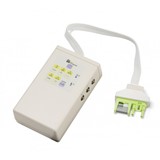In the ever-evolving landscape of medical technology, one field that has witnessed remarkable progress is Electrocardiography (ECG). ECG is a non-invasive diagnostic tool that measures the electrical activity of the heart, providing crucial information about cardiac health. Over the years, advancements in ECG technology and signal processing have revolutionized the way we diagnose and manage cardiovascular conditions.
Understanding ECG Technology
What is an ECG?
An Electrocardiogram, commonly known as an ECG or EKG (Electrocardiograph), is a graphical representation of the electrical activity of the heart. It records the electrical impulses that travel through the heart as it contracts and relaxes, creating characteristic wave patterns.
Traditional ECG Systems
Traditional ECG systems have been in use for decades, employing electrodes placed on the skin's surface to detect and record the heart's electrical signals. These systems provide valuable information, but they come with limitations in terms of mobility and ease of use.
Advancements in ECG Technology
Wearable ECG Devices
One of the most significant advancements in recent years is the development of wearable ECG devices. These compact and portable gadgets allow individuals to monitor their heart health continuously, even in their daily routines. Wearable ECGs offer real-time data, enabling early detection of irregularities and better management of heart conditions.
Wireless ECG Monitoring
Wireless ECG monitoring has taken patient care to new heights. With wireless technology, patients can now wear small, adhesive ECG patches that transmit data to monitoring systems without cumbersome wires. This seamless data transfer enhances patient comfort, leading to more accurate readings.
Smartphone Integration
Integration of ECG technology with smartphones has democratized access to heart health monitoring. Several smartphone apps and add-on devices enable users to record ECGs at home and share them with healthcare professionals. This accessibility encourages proactive heart health management.
AI-Powered ECG Analysis
Artificial Intelligence (AI) has made its way into ECG analysis, empowering clinicians to make faster and more accurate diagnoses. AI algorithms can detect subtle anomalies in ECG waveforms, aiding in the early identification of potential cardiac issues.
Miniaturization and Implantable Devices
The miniaturization of ECG devices has paved the way for implantable monitors that continuously track heart activity for extended periods. These devices are especially valuable for patients with suspected arrhythmias or those at risk of sudden cardiac events.
Signal Processing Techniques
Noise Reduction
Signal processing plays a vital role in enhancing the quality of ECG recordings. Noise reduction techniques eliminate interference caused by muscle activity, electrode artifacts, and other external factors, resulting in cleaner and more accurate signals.
Baseline Wander Removal
Baseline wander, a slow drift in the ECG signal caused by respiration and body movement, can obscure critical waveform details. Advanced signal processing algorithms effectively remove baseline wander, ensuring precise ECG interpretation.
Arrhythmia Detection
Signal processing algorithms are instrumental in identifying arrhythmias, irregular heart rhythms that may indicate underlying cardiac issues. Timely detection of arrhythmias is essential for appropriate medical intervention.
ST-Segment Analysis
The ST-segment of an ECG represents the period between ventricular depolarization and repolarization. Signal processing techniques enable precise analysis of the ST-segment, aiding in the diagnosis of myocardial ischemia and other heart conditions.
High-Resolution ECG Signal Acquisition for Enhanced Diagnostics
Electrocardiography (ECG) is a vital diagnostic tool used to assess the electrical activity of the heart and identify various cardiac conditions. The accuracy and precision of ECG signal acquisition play a crucial role in enabling healthcare professionals to make informed decisions about patient care. In recent years, there have been significant advancements in high-resolution ECG signal acquisition techniques, revolutionizing the field of cardiac diagnostics and enhancing patient outcomes.
The Need for High-Resolution ECG Signal Acquisition
Standard ECG machines typically sample the cardiac electrical signals at a rate of 500 Hz. While this sampling rate has been sufficient for detecting common cardiac abnormalities, it may not capture subtle changes in the heart's electrical activity. High-resolution ECG signal acquisition, on the other hand, involves sampling at much higher frequencies, often in the kilohertz range. This increased sampling rate allows for more detailed and accurate representation of the ECG waveform, enabling healthcare professionals to detect and diagnose conditions that might go unnoticed with standard ECGs.
Advantages of High-Resolution ECG Signal Acquisition
1. Enhanced Signal Fidelity
High-resolution ECG signal acquisition captures the minute electrical changes that occur during the cardiac cycle. As a result, the ECG waveform obtained is more faithful to the heart's true electrical activity. This enhanced signal fidelity enables the detection of subtle waveform alterations that might indicate early signs of cardiac dysfunction.
2. Improved Signal-to-Noise Ratio
Noise interference is a common challenge in ECG signal acquisition. High-resolution techniques, by virtue of capturing a more detailed signal, inherently result in an improved signal-to-noise ratio. This means that the true ECG waveform is more distinct from the background noise, making it easier for healthcare professionals to interpret the ECG accurately.
3. Early Detection of Cardiac Abnormalities
With high-resolution ECG signal acquisition, even minor changes in the ECG waveform can be identified promptly. This early detection of cardiac abnormalities allows for timely intervention and treatment, potentially preventing the progression of heart conditions and reducing the risk of complications.
4. Better Characterization of Arrhythmias
Arrhythmias, irregular heart rhythms, can be challenging to diagnose accurately. High-resolution ECG signal acquisition provides a more detailed view of the heart's electrical activity during arrhythmias, facilitating better characterization of the rhythm disorder. This detailed information is invaluable for guiding treatment decisions.
5. Uncovering Hidden Cardiac Conditions
Some cardiac conditions may manifest with subtle electrical abnormalities that are not evident in standard ECGs. High-resolution signal acquisition can uncover these hidden cardiac conditions, enabling healthcare professionals to provide tailored and targeted treatment plans.
High-Resolution ECG Signal Acquisition Techniques
1. High-Frequency Sampling
High-resolution ECG machines utilize high-frequency sampling techniques, typically ranging from 1000 to 2000 Hz or even higher. This increased sampling rate captures more data points during each cardiac cycle, resulting in a finely detailed waveform.
2. Signal Averaging
Signal averaging is a signal processing technique commonly used in high-resolution ECG signal acquisition. It involves recording multiple ECG cycles and averaging them to reduce random noise, further enhancing the signal-to-noise ratio.
3. Multi-Lead ECG Systems
Conventional ECGs often use a limited number of leads to record electrical activity from specific angles. High-resolution ECG systems may employ multi-lead configurations, capturing electrical signals from multiple viewpoints for a comprehensive assessment of cardiac function.
Applications of High-Resolution ECG Signal Acquisition
1. Early Detection of Myocardial Ischemia
High-resolution ECG signal acquisition has shown promise in the early detection of myocardial ischemia, a condition characterized by reduced blood flow to the heart muscles. By detecting subtle ST-segment deviations, healthcare professionals can identify patients at risk of heart attacks and implement appropriate interventions.
2. Assessment of Cardiomyopathies
Cardiomyopathies are a group of heart muscle diseases that can lead to heart failure. High-resolution ECG signal acquisition aids in the early diagnosis and classification of various cardiomyopathies, guiding treatment strategies and monitoring disease progression.
3. Evaluation of Drug-Induced Cardiotoxicity
Certain medications can have adverse effects on the heart, leading to drug-induced cardiotoxicity. High-resolution ECG signal acquisition helps detect drug-induced changes in cardiac electrical activity, enabling physicians to adjust medication regimens as needed
Signal Noise Reduction Techniques in Modern ECG Machines
Electrocardiography (ECG) is a crucial diagnostic tool used to assess the electrical activity of the heart and identify various cardiac conditions. However, the accuracy of ECG readings can be affected by various sources of noise, which can obscure important waveform details and compromise the diagnostic process. To address this challenge, modern ECG machines incorporate advanced signal noise reduction techniques that enhance the quality and reliability of ECG recordings. In this article, we will explore some of the key signal noise reduction techniques used in modern ECG machines.
1. Filtering Algorithms
Filtering is a fundamental noise reduction technique used in ECG signal processing. Filtering algorithms are applied to the raw ECG data to remove unwanted noise while preserving the essential cardiac signal. Two primary types of filters are commonly used:
a. Low-Pass Filters
Low-pass filters allow low-frequency signals (such as noise) to pass through while attenuating higher-frequency components. These filters are effective in eliminating baseline wander and muscle artifacts, which are typically low-frequency noise sources.
b. High-Pass Filters
High-pass filters, on the other hand, allow higher-frequency components (including the ECG signal) to pass while attenuating low-frequency noise. High-pass filters are useful for removing interference caused by power line hum and electrode contact noise.
2. Baseline Wander Removal
Baseline wander refers to the slow drift in the ECG signal caused by respiration, body movement, and other non-cardiac sources. Baseline wander can obscure important features of the ECG waveform, making accurate interpretation challenging. Modern ECG machines employ sophisticated algorithms to detect and remove baseline wander, ensuring clearer and more accurate ECG recordings.
3. Notch Filters
Notch filters, also known as band-stop filters, are designed to eliminate specific narrow frequency bands, such as power line interference at 50 or 60 Hz. These filters effectively reduce power line artifacts, ensuring that the ECG signal remains unaffected by electrical mains noise.
4. Adaptive Filtering
Adaptive filtering is a dynamic noise reduction technique that adjusts filter parameters based on the characteristics of the noise present in the ECG signal. By continuously adapting to changing noise conditions, adaptive filtering can effectively suppress noise without compromising the integrity of the cardiac signal.
5. Wavelet Transform
Wavelet transform is a powerful signal processing tool used for denoising ECG recordings. It decomposes the ECG signal into different frequency components, allowing the identification and removal of noise at specific scales. Wavelet transform-based denoising is particularly effective in dealing with non-stationary noise sources.
6. Ensemble Averaging
Ensemble averaging is a statistical technique used to reduce random noise in ECG recordings. It involves averaging multiple ECG cycles to attenuate the random noise components, enhancing the signal-to-noise ratio and revealing the underlying ECG waveform more clearly.
7. Independent Component Analysis (ICA)
Independent Component Analysis is a data-driven approach used to separate mixed signals into their underlying independent components. In the context of ECG signal noise reduction, ICA can isolate noise sources and effectively remove them from the recorded ECG signal.
Real-Time ECG Monitoring and Telemetry Innovations
Electrocardiography (ECG) plays a vital role in diagnosing and monitoring cardiac conditions, providing crucial insights into the electrical activity of the heart. In recent years, advancements in technology have led to the development of real-time ECG monitoring solutions with telemetry capabilities, revolutionizing the way we assess and manage heart health. In this article, we will explore the innovations in real-time ECG monitoring and telemetry, their applications, and the benefits they offer to patients and healthcare professionals.
Real-Time ECG Monitoring: A Game-Changer
Traditionally, ECGs were recorded as snapshots during brief clinic visits, limiting the amount of data available for analysis. However, real-time ECG monitoring enables continuous and uninterrupted recording of the heart's electrical activity over an extended period. This real-time data empowers healthcare professionals with a comprehensive understanding of a patient's cardiac health, even during their regular activities.
Telemetry: Wireless Connectivity for Mobility
Telemetry is a wireless communication technology that allows ECG data to be transmitted in real-time from the patient to a remote monitoring station. This wireless connectivity eliminates the need for physical connections between the patient and the monitoring equipment, enabling mobility and freedom of movement during monitoring.
Advantages of Real-Time ECG Monitoring and Telemetry
1. Continuous Monitoring for High-Risk Patients
Real-time ECG monitoring with telemetry is particularly beneficial for high-risk patients, such as those with a history of cardiac conditions or those recovering from heart procedures. Continuous monitoring allows healthcare professionals to detect and respond promptly to any changes or irregularities in the patient's heart rhythm.
2. Early Detection of Arrhythmias
Arrhythmias, irregular heart rhythms, can be challenging to diagnose, as they may occur intermittently. Real-time ECG monitoring captures any deviations from the normal heart rhythm as they happen, facilitating early detection and accurate diagnosis of arrhythmias.
3. Remote Patient Monitoring
Telemetry capabilities enable remote patient monitoring, where ECG data can be transmitted securely to healthcare providers in real-time, regardless of the patient's location. This remote monitoring is particularly valuable for patients in rural areas or those who have difficulty accessing healthcare facilities regularly.
4. Post-Operative Care
Real-time ECG monitoring is beneficial for patients recovering from cardiac procedures or surgeries. Healthcare professionals can closely monitor the patient's heart function during the recovery phase, ensuring early detection of any post-operative complications.
5. Long-Term Holter Monitoring
Holter monitors, which continuously record ECG data for 24 to 48 hours, have been used for long-term monitoring. The integration of telemetry with Holter monitors enhances their utility by allowing real-time transmission of data, improving patient comfort and convenience.
Innovations in Real-Time ECG Monitoring and Telemetry
1. Wearable ECG Devices
Advancements in wearable ECG devices have made real-time monitoring more accessible and convenient for patients. These compact and user-friendly wearables can be discreetly worn on the body, continuously recording ECG data and transmitting it via telemetry to a smartphone or a remote monitoring station.
2. Mobile Apps and Cloud Connectivity
Integration with mobile applications and cloud connectivity has facilitated real-time ECG monitoring and data storage. Patients can use ECG-enabled smartphone apps to record and transmit their ECG data securely to healthcare providers, promoting seamless communication and efficient data management.
3. Artificial Intelligence (AI) Integration
AI-powered algorithms can analyze real-time ECG data rapidly and accurately, assisting healthcare professionals in detecting abnormalities and making diagnostic decisions. The integration of AI with real-time ECG monitoring enhances the diagnostic capabilities of these systems.
4. Implantable ECG Devices
Implantable ECG devices offer a more invasive but long-term solution for real-time monitoring. These devices are surgically implanted within the body and can continuously record and transmit ECG data wirelessly, providing valuable insights into the patient's cardiac health over extended periods.
Applications of Advanced ECG Technology
Remote Patient Monitoring
The integration of advanced ECG technology with telemedicine has revolutionized remote patient monitoring. Healthcare providers can now track patients' cardiac health in real-time, enabling timely interventions and reducing hospital readmissions.
Sports and Fitness
Wearable ECG devices have found applications in the sports and fitness industry. Athletes can monitor their heart performance during training and competitions, optimizing their workouts for peak efficiency and safety.
Personal Health Tracking
For health-conscious individuals, ECG-enabled smartphones and wearable devices provide a convenient way to track heart health regularly. Users can observe patterns, detect anomalies, and take proactive steps towards a healthier lifestyle.
Future Prospects
The future of ECG technology and signal processing looks incredibly promising. As technology continues to advance, we can expect even more compact, accurate, and user-friendly ECG devices. AI-powered analytics will become more sophisticated, enabling earlier detection and personalized treatment plans.
Conclusion
The advancements in ECG technology and signal processing have ushered in a new era of cardiac care. From wearable devices to AI-driven analysis, these innovations have transformed the way we monitor and manage heart health. By leveraging these cutting-edge tools, individuals can take charge of their cardiovascular well-being and lead healthier lives.










